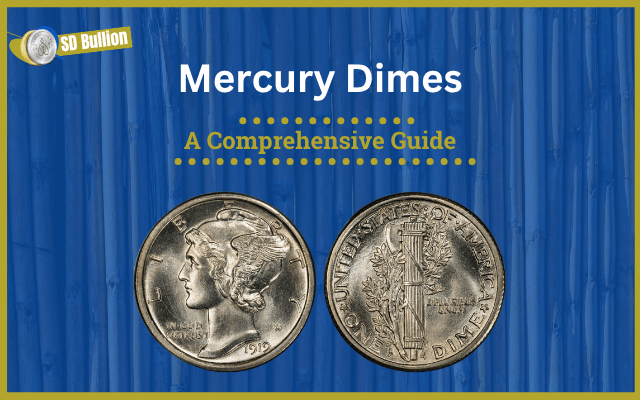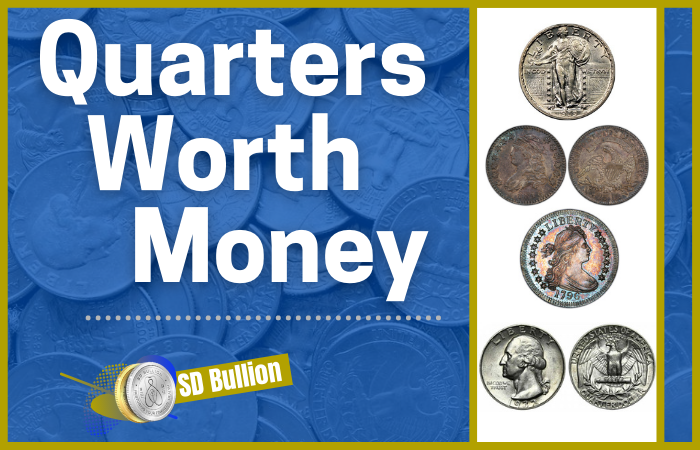Jump to: History of the Mercury Dime | Value and Design | Rare and Valuable Mercury Dimes | Key Dates | Price Chart | Investing in Mercury Dimes
Mercury Dimes are a treasure in the United States' coinage history and some key dates can be worth thousands of dollar, up to roughly $360,000!
Understanding Mercury Dimes
What is a Mercury Dime?
The Mercury dime is a 10-cent coin minted by the U.S. Mint from 1916 until 1945. The design is a depiction of Lady Liberty with a Phrygian cap (or winged cap). But the name Mercury comes from the resemblance to the Roman God Mercury, the Roman god of commerce.
In this article, I will explore what makes the Mercury dime not only a fascinating collectible but also a potential investment worth your attention.
Key Takeaways:
-
Iconic U.S. Coin (1916–1945): The Mercury Dime, also called the Winged Liberty Head dime, is a historical 90% silver coin with a design often mistaken for the Roman god Mercury. It was minted at the Philadelphia, Denver, and San Francisco mints.
-
Value Depends on Multiple Factors: Key influences on a coin’s value include mint mark, mintage year, grade (condition), and whether it features Full Bands — a highly collectible detail on the reverse fasces.
-
Key Dates Can Be Extremely Valuable: Some rare specimens, like the 1916-D, 1931-S Full Bands, and 1938-S, have sold for over $200,000, with pristine examples fetching even more.
-
Silver Content Adds Base Value: With 90% silver content, every Mercury Dime has an intrinsic melt value, making it appealing to both collectors and bullion investors, regardless of collectible premium.
-
Professional Grading Matters: Coins graded by services like PCGS or NGC, especially those certified with Full Bands or high Mint State grades (MS65+), command significantly higher prices in the market.
-
Selling and Buying Tips: For best results, research the market, consider professional appraisals, and sell through trusted dealers or auction houses. Online marketplaces offer wide access, but coin shows and local shops allow in-person inspection.
History of the Winged Liberty Head Dime (1916-1945)
Produced by the United States Mint from 1916 to 1945 at the Philadelphia, Denver, and San Francisco facilities, the Adolph Weinman designs replaced the Barber dime (from Charles E. Barber) and were later replaced in 1946 by the Roosevelt Dime.
Mercury Dime Values
Factors Affecting Mercury Dime Values
Date and Mintmark
Mint Marks are letters placed on the obverse of a coin to indicate which facility of the U.S. Mint the coin was minted at. Some facilities mint fewer coins than others, which can lead to a higher rarity level. Other facilities, such as New Orleans (O) or Carson City (CC), were closed relatively recently and are mint marks sought after for collectors who value historical background.
Combine with dates, which represent the age of the coin. Depending on several factors, some dates may be rarer due to limited production. Interestingly, a pattern seems to emerge in the Mercury series, as many older coins minted in San Francisco are associated with rare and limited issues.
Grading Condition
Grading plays a crucial role in determining the coin values. To put it simply, the most acceptable way of classifying a coin's condition is the Sheldon Scale, which ranges from 1 to 7. Coins graded between 60 to 70 are considered in Mint State, or uncirculated condition.
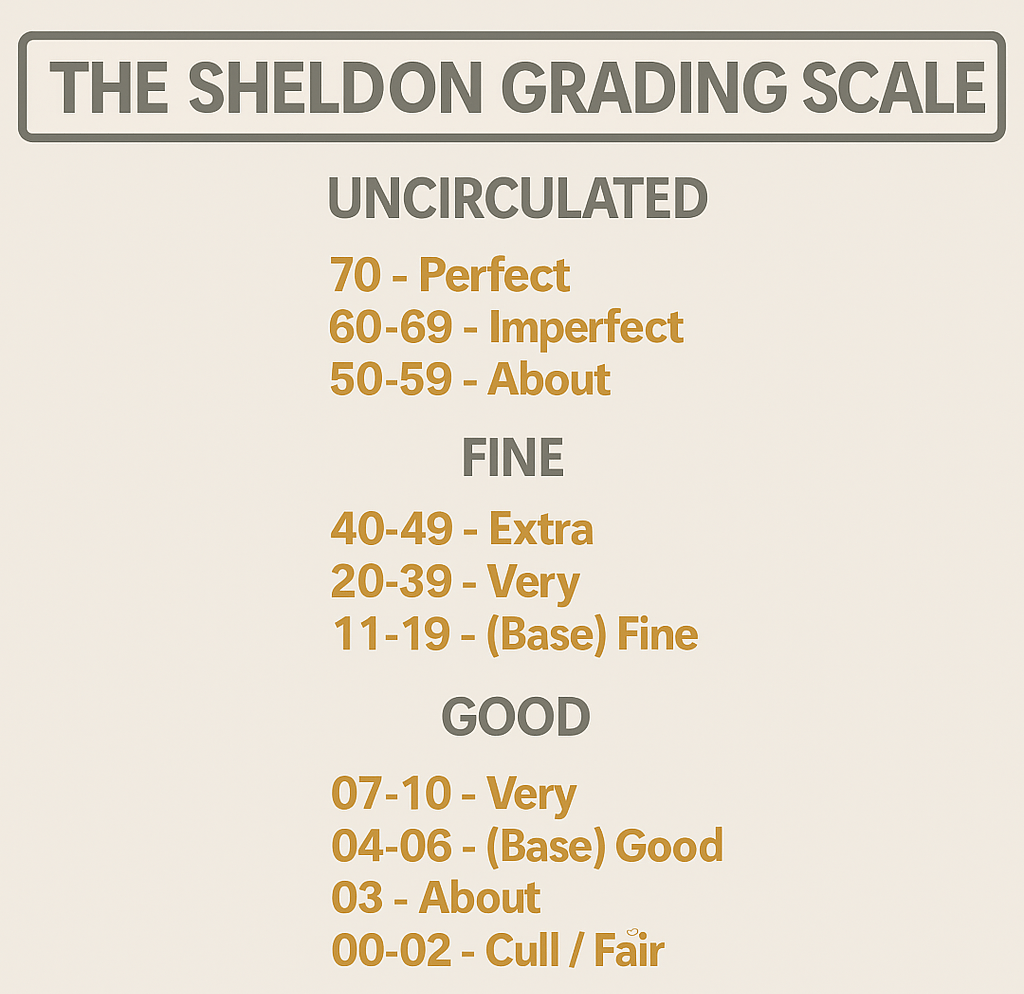
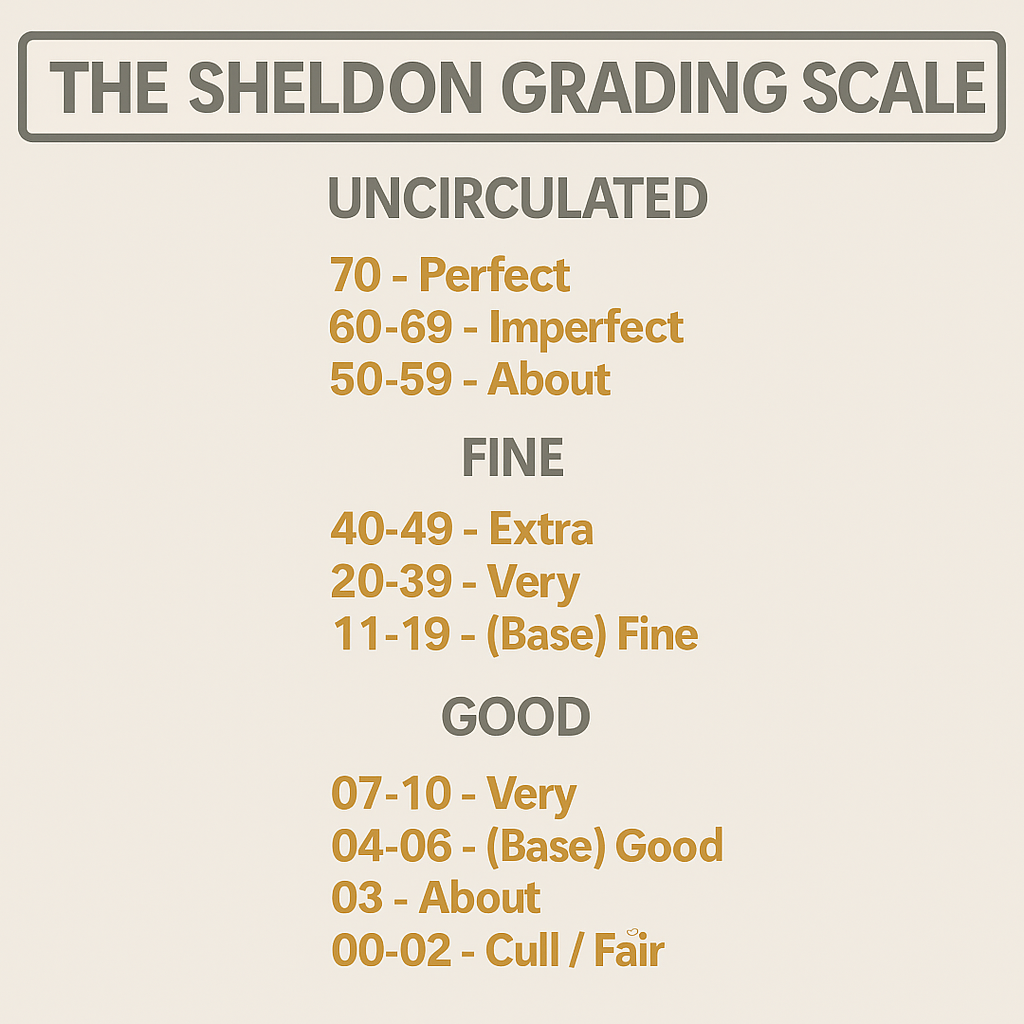
Design
The obverse coin design features a young Liberty surrounded by the word "LIBERTY," the motto "IN GOD WE TRUST," and the year near her neck.
Liberty, just like in the silver dollars, wears a Phrygian cap, but now with wings, which led many to nickname the coin "Mercury" due to its resemblance to the Roman god. While the cap wasn’t originally a symbol of freedom, it later came to represent liberty, especially during the American and French Revolutions. The wings symbolize freedom of thought.
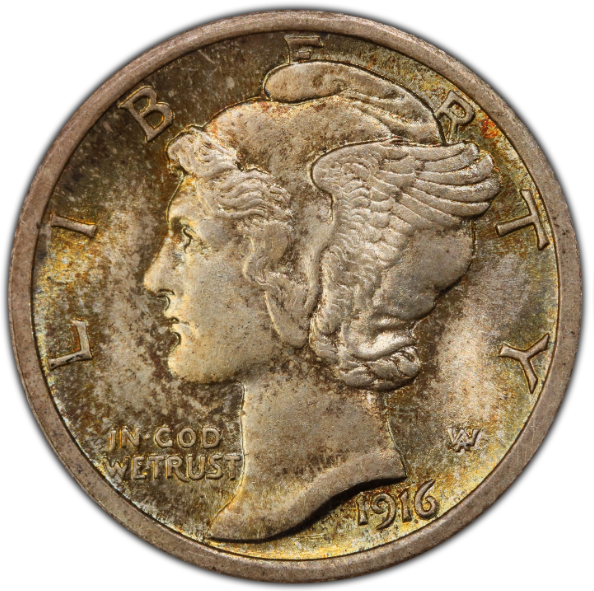
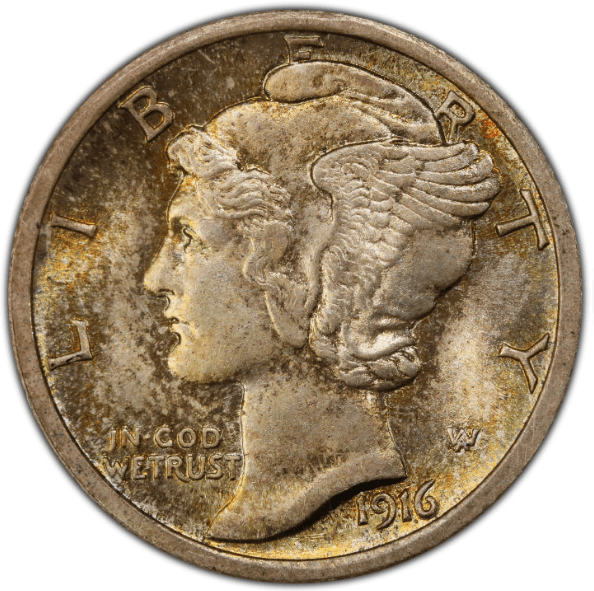
Obverse of the 1916-D Mercury Dime: Liberty’s Winged Cap and the Freedom of Thought.
The reverse features the inscriptions "UNITED STATES OF AMERICA," "ONE DIME," and the Latin phrase "E pluribus unum," meaning "Out of many, one", a reference to the union of the original thirteen colonies.
At the center is a fasces, a bundle of wooden rods (sometimes with an axe) symbolizing strength through unity, embraced by an olive branch, often used to represent the desire for peace in American coinage. The mint mark is placed at the bottom right, near the rim.
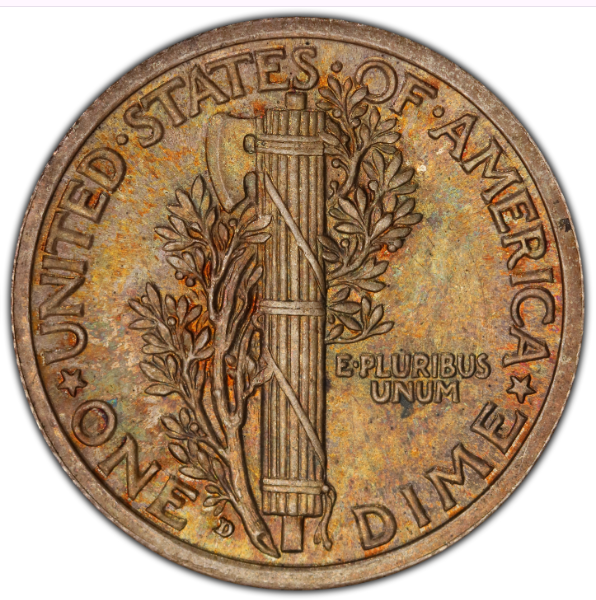
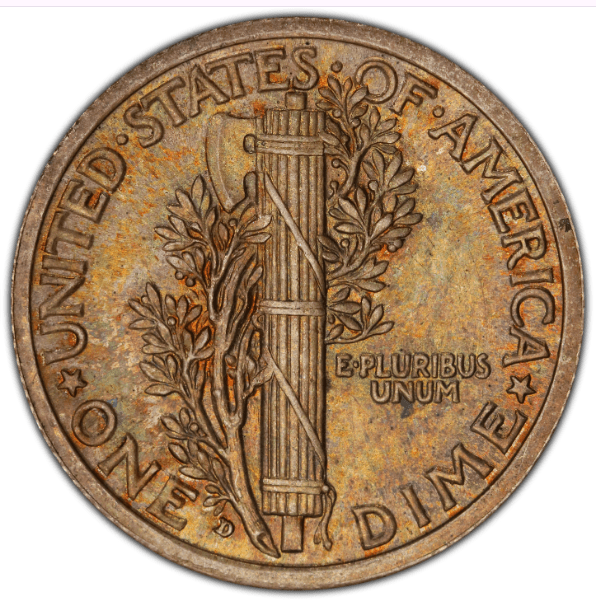
An emblem of American ideals on the 1916-D Mercury Dime: strength, unity, and the pursuit of peace.
Silver Content
Although the coin contains only a modest amount of silver, its precious-metal content still plays a significant role in its value. Silver has been prized for centuries as both an adornment and a store of wealth, and many modern investors continue to “stack” it as a hedge against inflation.


Even though its spot price is far lower than gold’s, the presence of any silver gives the coin an intrinsic melt value (way higher than the face value) , plus a nostalgic appeal as a relic of the days when precious metals circulated in everyday U.S. currency.
In other words, the small silver fraction not only provides a tangible floor under the price but also boosts the coin’s desirability to collectors and coin dealers.
Want to learn more about Junk Silver? Read everything you need to know in our Junk Silver Guide.
Rare and Valuable Mercury Dimes
Here are the 10 most valuable Mercury dimes ever sold, ranked by record auction price, with each coin’s highest known sale value.
10. 1935-S Mercury Dime – $90,000
9. 1945 Mercury Dime – $96,000
8. 1923-S Mercury Dime – $105,750
7. 1942/1 Mercury Dime – $120,000
6. 1919-S Mercury Dime MS66 Full Bands – $132,000
5. 1919-D Mercury Dime MS66 Full Bands – $156,000
4. 1918-S Mercury Dime MS67+ Full Bands – $182,125
3. 1916-D Mercury Dime MS67+ Full Bands – $207,000
2. 1931-S Mercury Dime Full Bands MS67 – $270,250
1. 1938-S Mercury Dime MS68 – $364,250
Key Dates and Rare Varieties
1919-D Mercury Dime
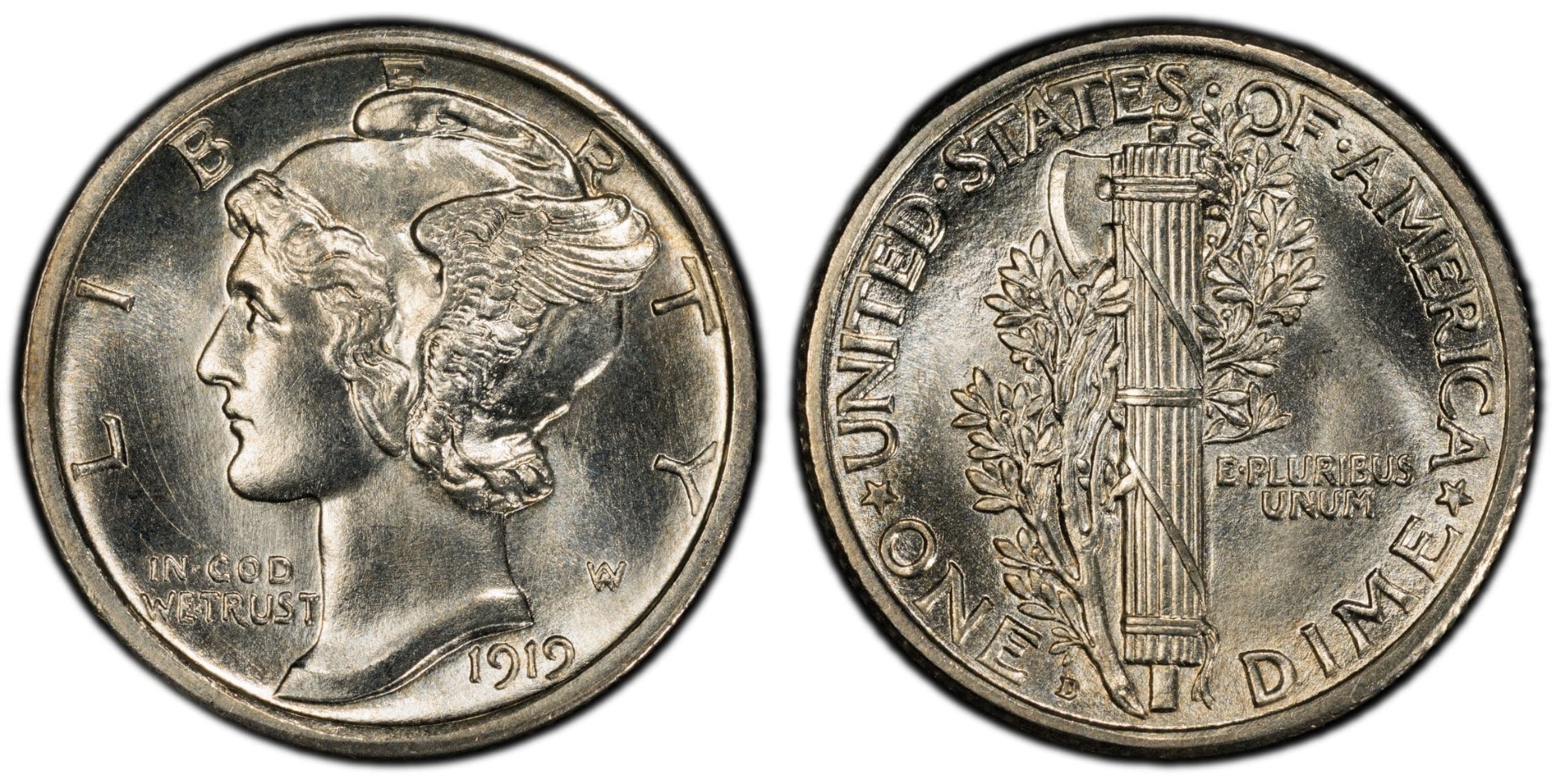
The 1919 Denver Mint Mercury dime is valuable because, despite its high mintage of nearly 10 million coins, it's extremely rare in top condition with Full Bands, a sign of a strong, complete strike. Most of these coins were heavily circulated and not preserved for their strike quality.
Only five are known in MS66 Full Bands grade, with none graded higher, and just two of those are endorsed by CAC, which verifies top-tier quality. This makes it a rare and prized coin for serious collectors and registry set builders.
The Auction Record for this coin was set in 2019, when it was sold for $156,000 at Heritage Auctions.
1918-S Mercury Dime Full Bands
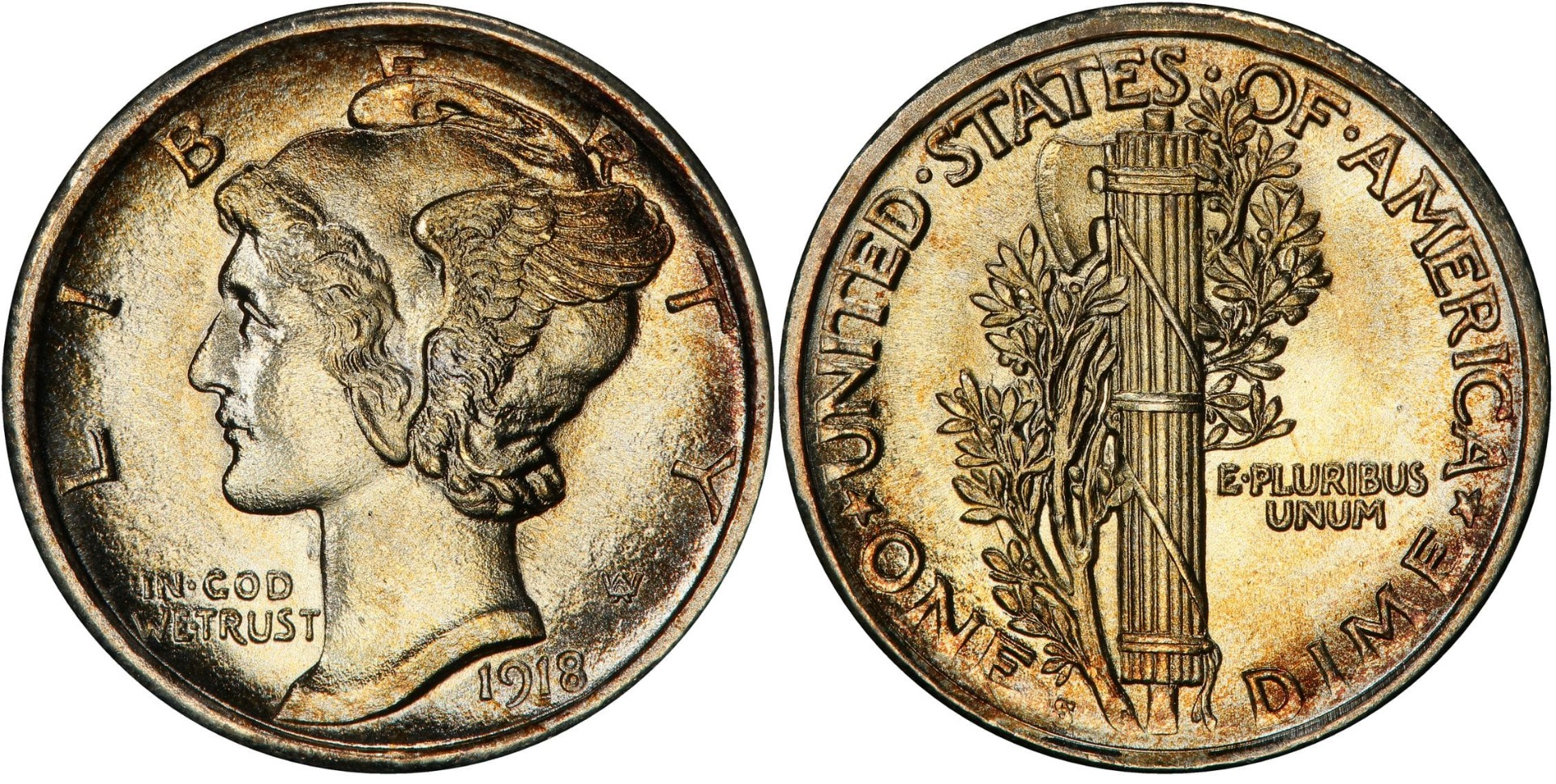
The price difference between the regular and Full Bands versions is so striking that it warrants an explanation. On the reverse of the Mercury dime, the primary device resembles a bundle of sticks with an axe, wrapped in vines of olive leaves. Holding everything together are three sets of twin bands.
The "Full Bands" designation is awarded to Mercury dimes where the central (middle) set of bands is fully split down the middle, a small detail that can have a significant impact on value.
For Mercury dime collectors, this distinction is crucial. It can mean a difference of thousands of dollars.
Take the two coins shown below as an example: the one on the left, graded MS66, holds a record of $7,200. The one on the right, graded MS67 with Full Bands, reached a staggering $144,000 in the same year, despite being in only slightly better condition. A little before that, in 2015, a similar coin, graded the same, had sold for $182,125 at a rare coin auction.
A specimen in slightly better condition (MS67+) is evaluated at 200,000 according to PCGS professionals.
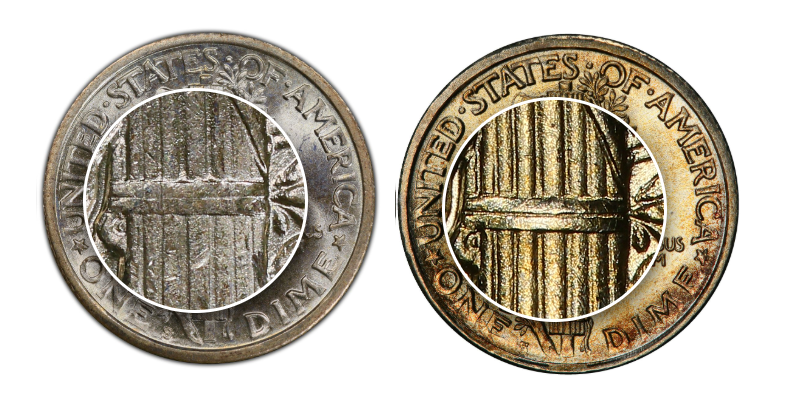
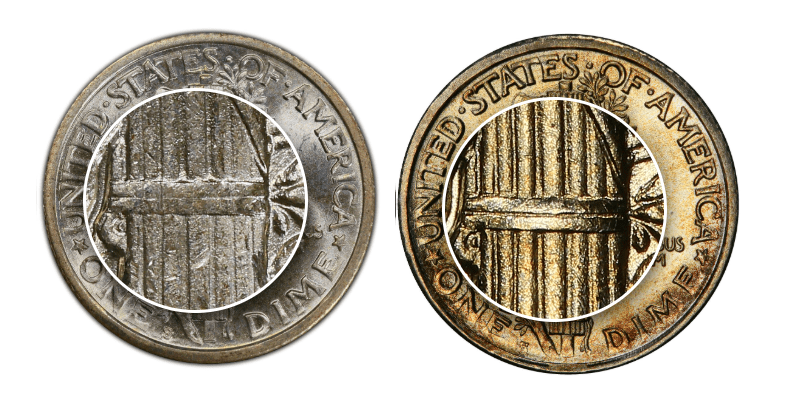
See how the bands on the regular coin on the left are not as sharp as the full band version on the right?
1916-D Mercury Dime
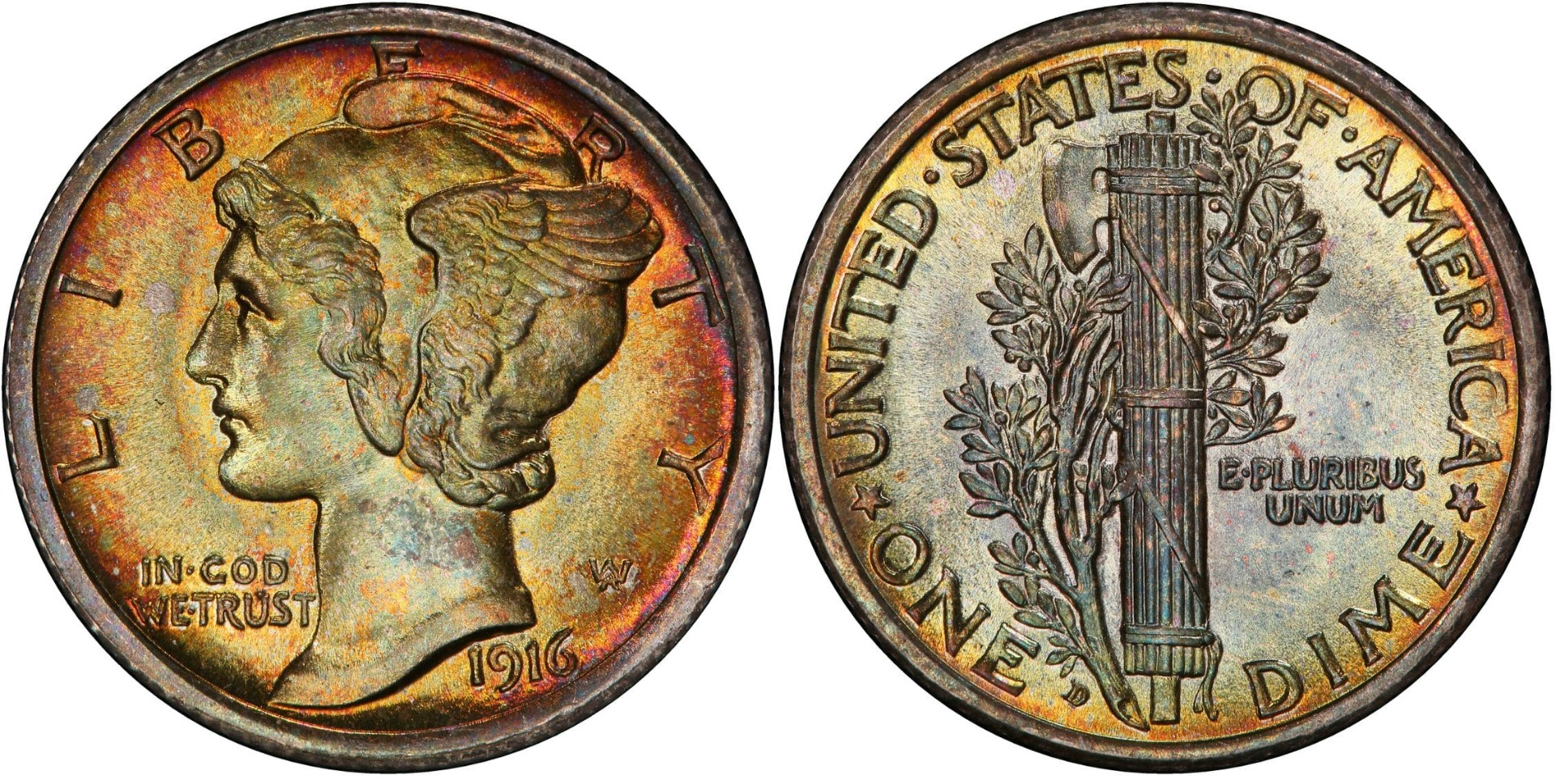
This is one of those coins that can sell for over $1,000, even in poor condition. In slightly better condition, say, uncirculated, it can be worth around $13,000, according to PCGS experts. These silver dimes range from 20,000 to 200,000 in Mint State (or uncirculated condition).
This silver coin is scarce, with a total mintage of just 264,000, the lowest in the series, making it valuable even in lower grades. Due to its notoriety, it's also among the most frequently counterfeited U.S. coins.
The record price for the Uncirculated coin shown above was $207,000, achieved at a Heritage Auctions sale in 2010.
1931-S Mercury Dime Full Bands
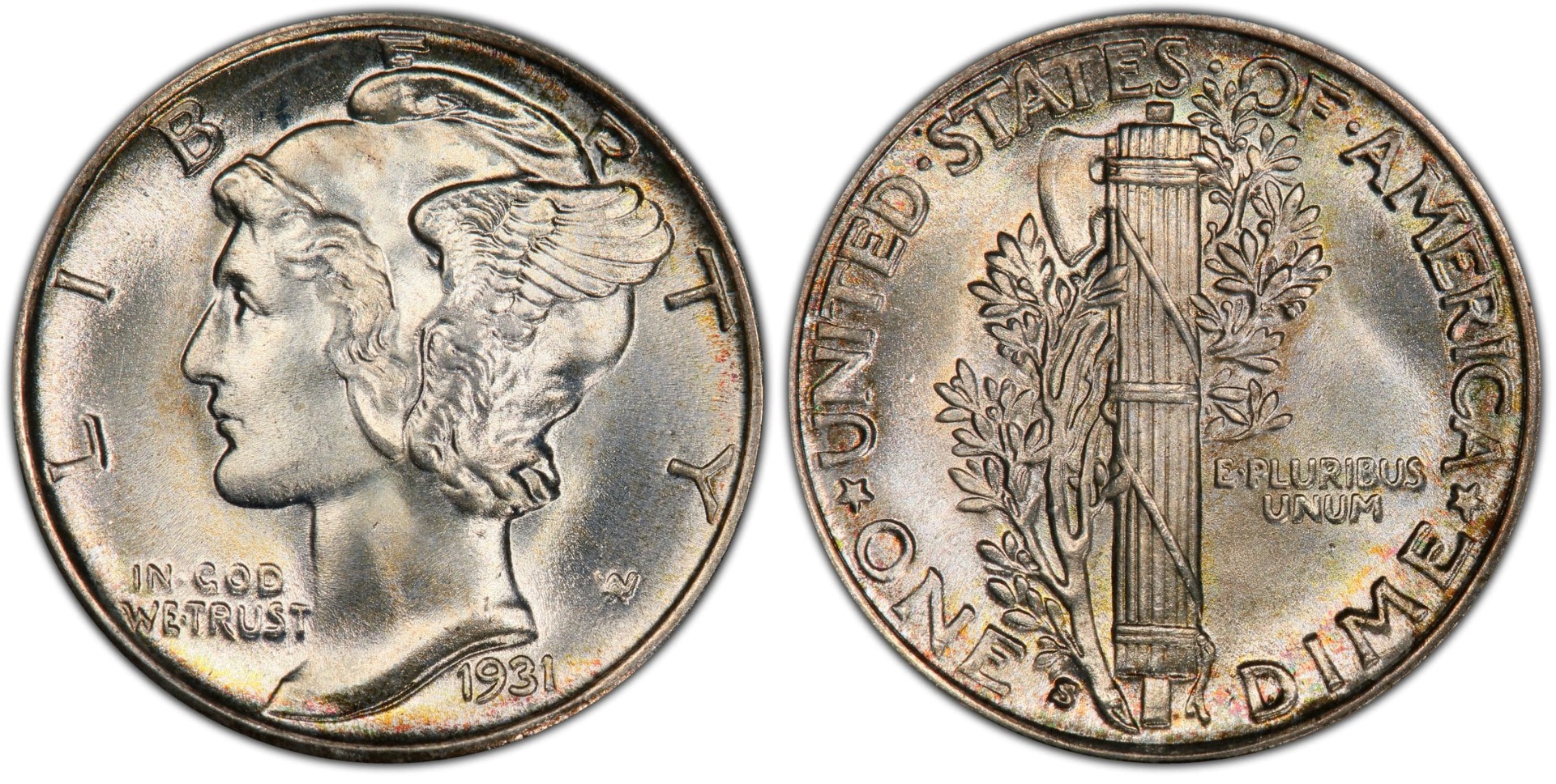
You've likely heard of the Great Depression: a global economic crisis that started in 1929 and lasted through much of the 1930s.
During that period, the demand for coin production dropped significantly, and the few coins that remained in circulation were often hoarded. That’s why finding a specimen in such exceptional condition is truly fortunate. Moreover, PCGS reports only two coins graded MS67, with none graded higher.
In 2019, the auction record for this San Francisco Mint coin was $270,250 at Legend Rare Coin Auctions.
1938-S Mercury Dime
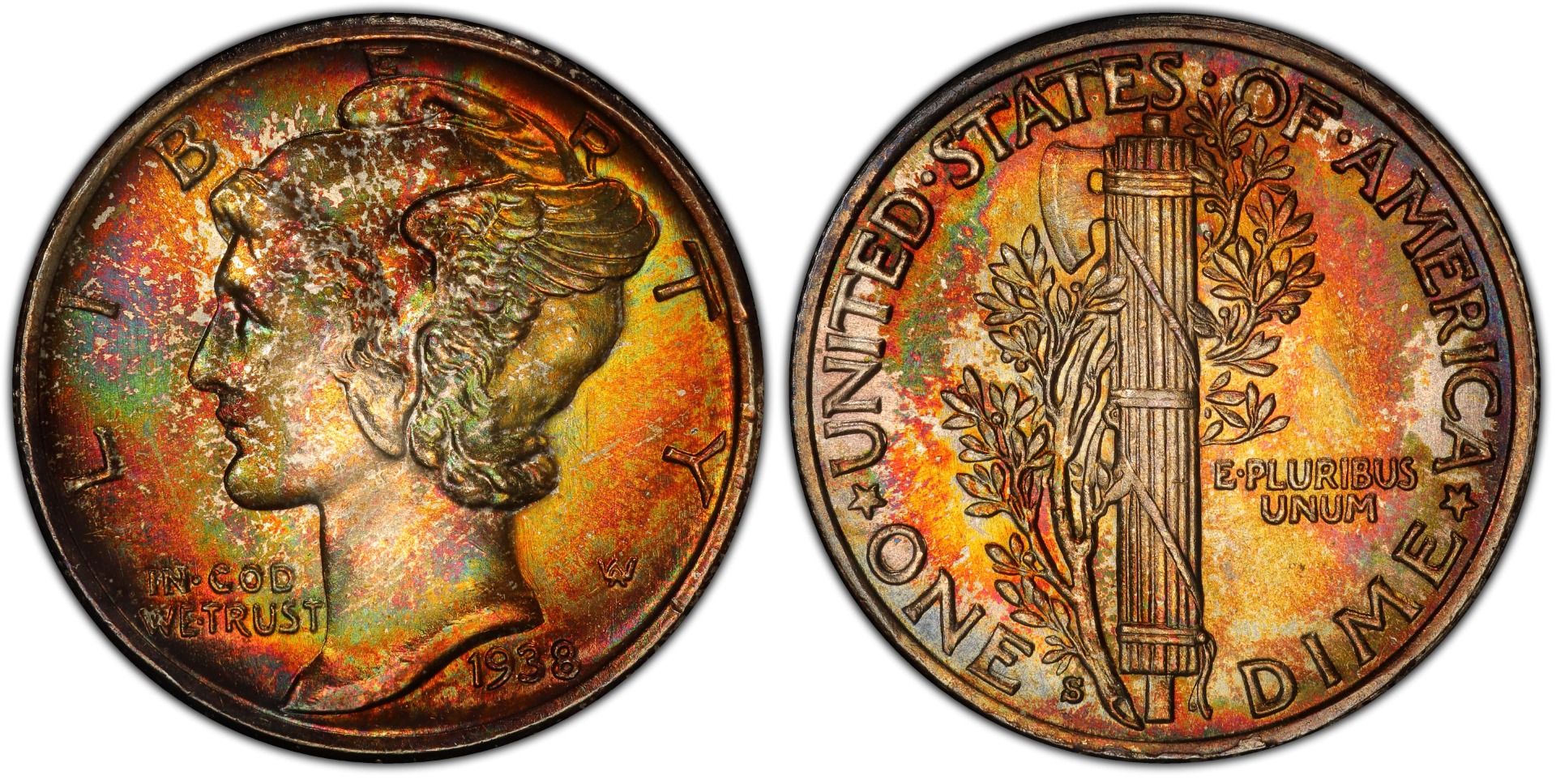
This is the only known specimen graded MS68 by PCGS. Mercury dimes in uncirculated condition are pretty rare, and the coin shown above was awarded a green bean by the Certified Acceptance Corporation (CAC). CAC verifies coins graded by other services and certifies those that meet the highest standards, essentially confirming that the coin is solid for its assigned grade.
The auction record for it was $364,250 in 2019 at Legend Rare Coin Auctions.
Pricing and Selling Mercury Dimes
Mercury Dime Price Charts
Explore Mercury Dime values (1916–1945) by grade; the price shown is estimated based on PCGS data.
|
Year |
Designation |
Mint Mark |
MS 65 |
MS 66 |
MS 67 |
MS 68 |
MS 68 |
|---|---|---|---|---|---|---|---|
|
1916 |
Mint State |
Philadelphia (no Mint Mark) |
190 |
425 |
1,250 |
3,250 |
- |
|
1916 |
Full Band |
Philadelphia (no Mint Mark) |
375 |
550 |
1,550 |
13,000 |
- |
|
1916 |
Mint State |
D |
33,500 |
55,000 |
- |
- |
- |
|
1916 |
Full Band |
D |
70,000 |
87,500 |
250,000 |
- |
- |
|
1916 |
Mint State |
S |
335 |
475 |
2,150 |
- |
- |
|
1916 |
Full Band |
S |
1,050 |
1,750 |
1,750 |
- |
- |
|
1917 |
MS |
- |
200 |
475 |
1,300 |
- |
- |
|
1917 |
FB |
- |
575 |
925 |
2,550 |
- |
- |
|
1917 |
MS |
D |
925 |
1,750 |
10,000 |
- |
- |
|
1917 |
FB |
D |
5,500 |
8,500 |
75,000 |
- |
- |
|
1917 |
MS |
S |
425 |
1,250 |
2,500 |
- |
- |
|
1917 |
FB |
S |
1,750 |
2,750 |
8,000 |
16,500 |
- |
|
1918 |
MS |
- |
525 |
1,650 |
- |
- |
- |
|
1918 |
FB |
- |
1,750 |
3,500 |
18,500 |
- |
- |
|
1918 |
MS |
D |
925 |
2,250 |
4,250 |
- |
- |
|
1918 |
FB |
D |
17,500 |
70,000 |
200,000 |
- |
- |
|
1918 |
MS |
S |
1,075 |
1,500 |
3,500 |
8,500 |
- |
|
1918 |
FB |
S |
14,000 |
30,000 |
160,000 |
- |
- |
|
1919 |
MS |
- |
500 |
1,050 |
2,350 |
- |
- |
|
1919 |
FB |
- |
1,250 |
1,850 |
11,500 |
- |
- |
|
1919 |
MS |
D |
1,600 |
4,750 |
10,000 |
- |
- |
|
1919 |
FB |
D |
40,000 |
135,000 |
- |
- |
- |
|
1919 |
MS |
S |
2,000 |
3,500 |
4,750 |
- |
- |
|
1919 |
FB |
S |
32,500 |
135,000 |
185,000 |
- |
- |
|
1920 |
MS |
- |
350 |
550 |
1,750 |
3,500 |
- |
|
1920 |
FB |
- |
475 |
675 |
3,750 |
14,000 |
- |
|
1920 |
MS |
D |
825 |
2,000 |
5,250 |
- |
- |
|
1920 |
FB |
D |
3,750 |
8,500 |
60,000 |
100,000 |
- |
|
1920 |
MS |
S |
1,850 |
3,250 |
- |
- |
- |
|
1920 |
FB |
S |
7,500 |
13,000 |
87,500 |
- |
- |
|
1921 |
MS |
- |
5,750 |
- |
- |
- |
- |
|
1921 |
FB |
- |
6,500 |
11,500 |
40,000 |
- |
- |
|
1921 |
MS |
D |
5,000 |
6,000 |
13,500 |
- |
- |
|
1921 |
FB |
D |
11,000 |
12,500 |
45,000 |
- |
- |
|
1923 |
MS |
- |
185 |
300 |
1,350 |
- |
- |
|
1923 |
FB |
- |
350 |
525 |
1,500 |
11,250 |
- |
|
1923 |
MS |
S |
1,250 |
2,500 |
3,500 |
- |
- |
|
1923 |
FB |
S |
8,000 |
100,000 |
120,000 |
- |
- |
|
1924 |
MS |
- |
250 |
700 |
1,650 |
- |
- |
|
1924 |
FB |
- |
575 |
1,275 |
4,500 |
16,500 |
- |
|
1924 |
MS |
D |
1,800 |
3,000 |
5,000 |
- |
- |
|
1924 |
FB |
D |
2,500 |
4,000 |
16,000 |
- |
- |
|
1924 |
MS |
S |
2,150 |
4,000 |
11,000 |
- |
- |
|
1924 |
FB |
S |
18,500 |
60,00 |
- |
- |
- |
|
1925 |
MS |
- |
400 |
950 |
1,750 |
- |
- |
|
1925 |
FB |
- |
1,000 |
1,875 |
3,600 |
47,500 |
- |
|
1925 |
MS |
D |
2,000 |
4,500 |
- |
- |
- |
|
1925 |
FB |
D |
5,250 |
8,250 |
22,500 |
- |
- |
|
1925 |
MS |
S |
1,500 |
3,500 |
- |
- |
- |
|
1925 |
FB |
S |
4,250 |
6,000 |
67,500 |
- |
- |
|
1926 |
MS |
- |
260 |
575 |
2,000 |
4,000 |
- |
|
1926 |
FB |
- |
475 |
825 |
3,150 |
- |
- |
|
1926 |
MS |
D |
700 |
2,000 |
4,250 |
- |
- |
|
1926 |
FB |
D |
2,850 |
4,750 |
42,500 |
- |
- |
|
1926 |
MS |
S |
5,000 |
7,000 |
12,500 |
- |
- |
|
1926 |
FB |
S |
11,000 |
35,000 |
75,000 |
- |
- |
|
1927 |
MS |
- |
200 |
475 |
950 |
- |
- |
|
1927 |
FB |
- |
600 |
700 |
1,750 |
22,500 |
- |
|
1927 |
MS |
D |
2,100 |
2,500 |
- |
- |
- |
|
1927 |
FB |
D |
8,500 |
20,000 |
42,500 |
- |
- |
|
1927 |
MS |
S |
1,850 |
4,000 |
8,500 |
- |
- |
|
1927 |
FB |
S |
7,750 |
20,000 |
75,000 |
- |
- |
|
1928 |
MS |
- |
165 |
350 |
1,100 |
- |
- |
|
1928 |
FB |
- |
425 |
675 |
2,250 |
22,500 |
- |
|
1928 |
MS |
D |
1,000 |
2,000 |
4,250 |
- |
- |
|
1928 |
FB |
D |
3,150 |
6,000 |
42,500 |
- |
- |
|
1928 |
MS |
S |
550 |
750 |
2,000 |
- |
- |
|
1928 |
FB |
S |
3,250 |
6,000 |
15,000 |
50,000 |
- |
|
1929 |
MS |
- |
155 |
375 |
650 |
- |
- |
|
1929 |
FB |
- |
400 |
525 |
1,450 |
13,500 |
- |
|
1929 |
MS |
D |
150 |
225 |
550 |
3,500 |
- |
|
1929 |
FB |
D |
450 |
675 |
2,000 |
25,000 |
- |
|
1929 |
MS |
S |
275 |
375 |
800 |
2,500 |
- |
|
1929 |
FB |
S |
625 |
1,200 |
2,750 |
- |
- |
|
1930 |
MS |
- |
160 |
275 |
2,150 |
- |
- |
|
1930 |
FB |
- |
725 |
1,250 |
3,250 |
- |
- |
|
1930 |
MS |
S |
425 |
575 |
1,750 |
- |
- |
|
1930 |
FB |
S |
1,625 |
2,000 |
4,750 |
- |
- |
|
1931 |
MS |
- |
210 |
375 |
1,750 |
- |
- |
|
1931 |
FB |
- |
725 |
1,350 |
3,750 |
- |
- |
|
1931 |
MS |
D |
375 |
600 |
1,600 |
- |
- |
|
1931 |
FB |
D |
650 |
1,050 |
2,500 |
- |
- |
|
1931 |
MS |
S |
425 |
625 |
1,250 |
4,000 |
- |
|
1931 |
FB |
S |
3,250 |
4,250 |
25,000 |
- |
- |
|
1934 |
MS |
- |
70 |
115 |
325 |
2,000 |
- |
|
1934 |
FB |
- |
215 |
250 |
450 |
2,500 |
- |
|
1934 |
MS |
D |
160 |
275 |
750 |
1,750 |
- |
|
1934 |
FB |
D |
375 |
925 |
2,250 |
7,500 |
- |
|
1935 |
MS |
- |
80 |
125 |
225 |
1,000 |
- |
|
1935 |
FB |
105 |
190 |
500 |
2,500 |
- |
|
|
1935 |
MS |
D |
125 |
200 |
1,050 |
3,750 |
- |
|
1935 |
FB |
D |
425 |
800 |
2,150 |
- |
- |
|
1935 |
MS |
S |
110 |
135 |
350 |
2,600 |
- |
|
1935 |
FB |
S |
550 |
700 |
1,450 |
90,000 |
- |
|
1936 |
MS |
- |
60 |
85 |
110 |
1,150 |
- |
|
1936 |
FB |
- |
125 |
210 |
450 |
1,850 |
- |
|
1936 |
MS |
D |
90 |
135 |
360 |
- |
- |
|
1936 |
FB |
D |
275 |
400 |
725 |
4,500 |
- |
|
1936 |
MS |
S |
60 |
100 |
250 |
1,500 |
- |
|
1936 |
FB |
S |
175 |
250 |
700 |
22,500 |
- |
|
1937 |
MS |
- |
53 |
75 |
110 |
450 |
- |
|
1937 |
FB |
- |
70 |
150 |
275 |
1,850 |
- |
|
1937 |
MS |
D |
55 |
80 |
225 |
1,600 |
- |
|
1937 |
FB |
D |
135 |
215 |
500 |
2,250 |
- |
|
1937 |
MS |
S |
115 |
175 |
275 |
1,500 |
- |
|
1937 |
FB |
S |
300 |
375 |
875 |
11,000 |
- |
|
1938 |
MS |
- |
53 |
75 |
125 |
750 |
- |
|
1938 |
FB |
- |
130 |
175 |
300 |
4,000 |
- |
|
1938 |
MS |
D |
60 |
95 |
235 |
1,750 |
- |
|
1938 |
FB |
D |
120 |
190 |
425 |
3,000 |
- |
|
1938 |
MS |
S |
65 |
85 |
225 |
850 |
- |
|
1938 |
FB |
S |
185 |
375 |
850 |
6,750 |
- |
|
1939 |
MS |
- |
53 |
85 |
160 |
600 |
8,250 |
|
1939 |
FB |
- |
210 |
300 |
825 |
3,750 |
- |
|
1939 |
MS |
D |
53 |
100 |
125 |
500 |
- |
|
1939 |
FB |
D |
120 |
160 |
275 |
1,050 |
9,750 |
|
1939 |
MS |
S |
60 |
100 |
335 |
2,000 |
- |
|
1939 |
FB |
S |
550 |
1,550 |
3,500 |
14,500 |
- |
|
1940 |
MS |
- |
53 |
75 |
110 |
625 |
- |
|
1940 |
FB |
- |
95 |
125 |
250 |
3,750 |
- |
|
1940 |
MS |
D |
53 |
75 |
110 |
1,250 |
- |
|
1940 |
FB |
D |
68 |
100 |
250 |
1,450 |
- |
|
1940 |
MS |
S |
53 |
75 |
225 |
2,000 |
- |
|
1940 |
FB |
S |
135 |
180 |
525 |
3,250 |
- |
|
1941 |
MS |
- |
53 |
75 |
110 |
750 |
- |
|
1941 |
FB |
- |
68 |
105 |
210 |
2,600 |
- |
|
1941 |
MS |
D |
53 |
75 |
110 |
700 |
- |
|
1941 |
FB |
D |
68 |
100 |
240 |
1,750 |
- |
|
1941 |
MS |
S |
53 |
75 |
110 |
950 |
- |
|
1941 |
FB |
S |
75 |
135 |
265 |
3,000 |
- |
|
1942 |
MS |
- |
53 |
75 |
110 |
1,650 |
- |
|
1942 |
FB |
- |
68 |
100 |
375 |
2,350 |
- |
|
1942/1 |
MS |
- |
11,750 |
18,500 |
70,000 |
- |
- |
|
1942/1 |
FB |
- |
85,000 |
130,000 |
- |
- |
- |
|
1942 |
MS |
D |
53 |
75 |
110 |
625 |
- |
|
1942 |
FB |
D |
68 |
100 |
210 |
1,250 |
- |
|
1942/1-D |
MS |
D |
22,500 |
- |
- |
- |
- |
|
1942/1-D |
FB |
- |
35,000 |
50,000 |
125,000 |
- |
- |
|
1942 |
MS |
S |
55 |
75 |
140 |
1,250 |
- |
|
1942 |
FB |
S |
125 |
200 |
475 |
6,500 |
- |
|
1943 |
MS |
- |
53 |
75 |
110 |
450 |
- |
|
1943 |
FB |
- |
68 |
100 |
425 |
7,250 |
- |
|
1943 |
MS |
D |
53 |
75 |
110 |
1,150 |
- |
|
1943 |
FB |
D |
68 |
100 |
210 |
1,300 |
- |
|
1943 |
MS |
S |
53 |
75 |
110 |
950 |
- |
|
1943 |
FB |
S |
100 |
135 |
350 |
4,000 |
- |
|
1944 |
MS |
- |
53 |
75 |
110 |
700 |
- |
|
1944 |
FB |
- |
95 |
215 |
750 |
12,500 |
- |
|
1944 |
MS |
D |
53 |
75 |
110 |
450 |
- |
|
1944 |
FB |
D |
68 |
100 |
210 |
1,000 |
- |
|
1944 |
MS |
S |
60 |
105 |
150 |
725 |
- |
|
1944 |
FB |
S |
90 |
125 |
325 |
4,250 |
- |
|
1945 |
MS |
- |
55 |
75 |
210 |
2,000 |
- |
|
1945 |
FB |
- |
19,000 |
27,500 |
65,000 |
- |
- |
|
1945 FS-101 DDO |
MS |
- |
750 |
1,000 |
- |
- |
- |
|
1945 |
MS |
D |
53 |
75 |
110 |
625 |
- |
|
1945 |
FB |
D |
68 |
100 |
210 |
5,750 |
- |
|
1945 |
MS |
S |
53 |
75 |
225 |
875 |
7,500 |
|
1945 |
FB |
S |
125 |
325 |
625 |
7,750 |
- |
|
1945-S Micro |
MS |
S |
135 |
210 |
500 |
3,000 |
7,500 |
|
1945-S Micro |
MS |
S |
875 |
1,600 |
3,500 |
23,500 |
- |
How Much is My Mercury Dime Worth?
Tools such as the Sheldon Scale and other coin grading resources are available online for those looking to learn how to appraise a coin.
However, to avoid uncertainty, it's best to have your coin professionally appraised. Many collectors place high trust in certifications from PCGS or NGC.
Buying and Selling Mercury Dimes
Tips for Selling Your Mercury Dime
Several dates are scarce in high grades, which adds a premium. When selling, know the silver content to determine its minimum value. Research the market to set a fair price and match buyer expectations. For better results, consider selling through a reputable dealer or auction house, where bidding may increase the final purchase amount.
Where to Buy Iconic Mercury Dimes
Coin shows and collectible shops give you the chance to inspect the coins by yourself. Still, online marketplaces, such as eBay and Amazon, can provide you with exposure to dealers worldwide, so you can expect more competitive prices.


Look for reputable dealers who offer gold or other precious metals at fair prices. Check for certifications, online reviews, ANA affiliation (which ensures ethical standards), Best Business Bureau accreditation, and whether the dealer is a US Mint Authorized Purchaser; these are all strong signs of legitimacy and security.
Conclusion
Whether you're looking to sell or acquire Mercury dime collections, there are a few key details to consider.
First, remember that these coins are composed of 90% silver, which means they retain at least their melt value. Additionally, coins from 1929 were heavily hoarded, making good condition examples rarer today. This historical context, combined with mintage numbers, plays a significant role in a coin’s rarity.
When buying or selling, it's helpful to know that online dealers often offer lower prices, while local coin shops allow you to inspect the coin in person, which is an advantage for many collectors. Online platforms remain the most popular choice overall. If you're selling, don’t overlook auction houses, as they might fetch a higher-than-expected price for your coin.



